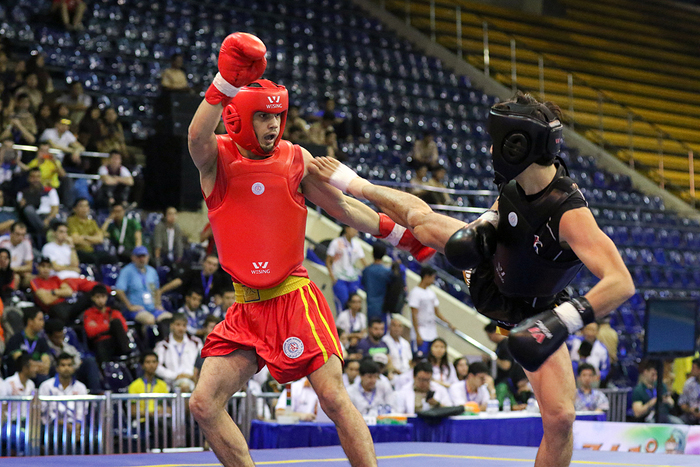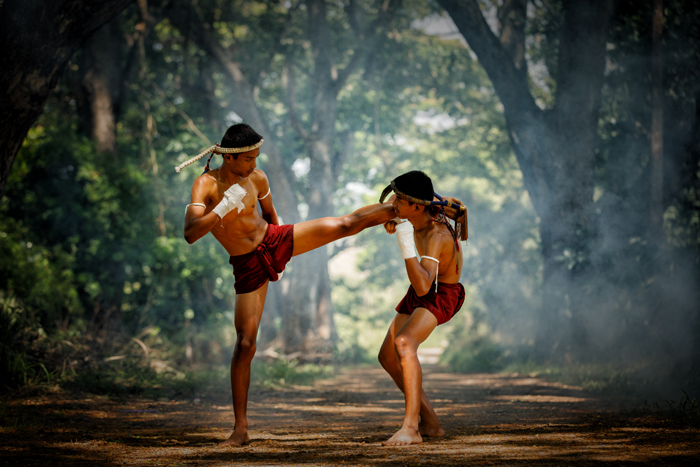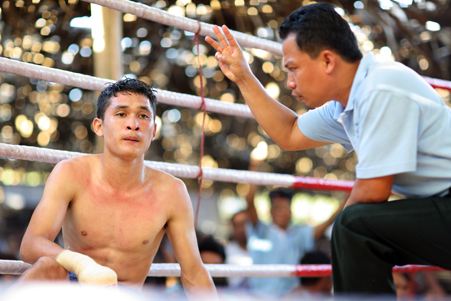Sanda - The Exciting Art of Chinese Kickboxing

Sanda, also known as Chinese kickboxing, is a full-contact sport and martial art that dates all the way back to ancient China. With a history thousands of years old, Sanda has evolved and transformed into a popular martial art that is now practiced worldwide. In this post, we will explore the fascinating history of Sanda, explain its rules, and compare Sanda to kickboxing, Muay Thai, and modern mixed martial arts.
History of Sanda
The history of Sanda can be traced back to ancient China, where various forms of martial arts were being practiced. Ancient China’s most popular martial art was Shoubo. This style involved punches, kicks, wrestling, and throwing techniques. Shoubo was one of the many ancient names given to this style of martial art. The style evolved into what is known today as Sanda.
During the Tang Dynasty (618–907 AD), a military training program called Jiao Li started incorporating combat techniques from Sanda. Jiao Li aimed to improve soldiers’ physical conditioning, combat skills, and martial arts skills. It became an essential part of the military training curriculum and played a significant role in shaping Sanda.
Sanda gained popularity amongst the Chinese people, and eventually they used raised lei tai platform arenas to hold competitions. The use of these arenas for combat competitions first became popular during the Zhou Dynasty (1046–256 BC). Participants engaged in full-contact fights using a combination of striking and wrestling techniques. This led to Sanda gaining popularity within the military as a competitive event since these battles were routinely held among troops to assess and teach barehanded combat.
In the 1960s, the Chinese government studied various traditional martial arts like Kung Fu and came to realize that Sanda was one of the most effective forms of combat. They began promoting Sanda and reintroducing it as part of their efforts to modernize martial arts training for military and law enforcement personnel. The Chinese government developed two versions of Sanda, one for self-defense and the other for sport. Although Sanda is usually practiced in the martial arts/sport form.
The Techniques of Sanda

Sanda is a wild blend of martial arts techniques that consists of kicks, punches, and takedowns. The techniques are blended from various martial arts like kung fu, catch wrestling, and judo. Sanda fighters employ the following techniques:
Punches
The punches practiced in Sanda are very similar to those taught in western boxing. Sanda fighters use jabs, crosses, hooks, and uppercuts. The angles of the punches are a bit different from boxing, as Sanda uses kicking techniques, and competitors need to be careful not to overexpose themselves to kicks.
Kicks
Sanda has a unique variety of kicks that it borrows from Kung Fu and kickboxing. These kicks can be very tricky to deal with; practitioners specialize in side kicks, roundhouse kicks, hook kicks, spinning back kicks, and front kicks.
Knee Strikes
Knee strikes are allowed in some Sanda fights; however, clinching and knee strikes to the head are not permitted.
Throws and Takedowns
The throws and takedowns are a mix of judo throws and catch wrestling. Takedowns are designed to be fast and spontaneous, aimed at scoring points rather than keeping an opponent down.
Sanda vs MMA

Although Sanda isn’t Kung Fu or MMA, it does look like a hybrid of the two styles, and it shares techniques from both. Sanda is like kickboxing, with wrestling and judo blended into it. It demonstrates the striking techniques of kickboxing, dynamic Judo throws, and some takedowns from wrestling.
Ground fighting is not allowed in Sanda, and this is how it differs a great deal from MMA. Since the grappling techniques taught in Sanda are frequently constructed around striking, Sanda fighters are taught to include takedowns into their combos.
Sanda competitors do score points with throws, but they are not allowed to continue fighting on the ground. In Sanda, after a throw or takedown has been completed, both fighters must get back to their feet and fight standing again.
MMA does allow fighters to fight on the ground, using Brazilian Jiujitsu and allowing strikes on downed opponents; fights are often finished on the ground. With mixed martial arts, the possibilities are endless, as fighters can use more fighting styles like kickboxing, Muay Thai, and Sanda.
Overall, MMA is more effective as a combat sport. However, as a specialized form of stand-up fighting, Sanda is still very effective and more useful than some traditional Chinese martial arts.
What Are the Differences Between Sanda and Muay Thai?

Origins: Sanda has its roots in ancient Chinese martial arts such as Kung Fu, while Muay Thai originated in Thailand and comes from traditional Thai martial arts.
Techniques: Both Sanda and Muay Thai emphasize striking techniques using punches, kicks, elbows, and knees. However, there are some differences in execution and style. Muay Thai places a significant focus on clinching techniques, where fighters engage in close-range grappling and striking. Sanda incorporates more throws, takedowns, and wrestling techniques.
Rules: Sanda is a more regulated sport, usually done in a competitive environment with strict rules. Muay Thai has a less strict ruleset, and it has been designed as a combat sport for entertainment.
Protective Gear: In Sanda, competitors wear protective body gear, including helmets, gloves, mouthguards, and shin guards. In Muay Thai, fighters typically wear gloves and mouthguards, with optional shin guards for training or amateur bouts. This is where Muay Thai and Sanda differ greatly. The protective gear in Sanda means there is very little chance of knockouts, cuts, and injuries, whereas in Muay Thai, these things are common.
Cultural Context: Muay Thai is deeply rooted in Thai culture and is considered the national sport of Thailand. It is often practiced as a part of Thai cultural traditions and ceremonies.
Fighting Tournaments vs Combat Sport: Sanda fighters mostly fight in tournaments that are not held in such high regard as Muay Thai. They are usually not paid, and losing a fight will not impact a Sanda fighter’s career in such a harsh way. Muay Thai fighters compete in large events with high stakes, which means they need to treat it as a career as their livelihood might depend on it.
Training Methods: Muay Thai focuses much of its training on hitting heavy bags, running sparring, clinching, and other strength and conditioning techniques. Sand training is more controlled, with a lot of sparring and technique-based training taking place. The emphasis on strength and conditioning is not as popular in Sanda.
Do the Chinese Military Learn Sanda?
Yes, a variation of Sanda is used in some branches of the Chinese military. The form of Sanda used by the Chinese military is known as Junshi Sanda, and the technique was developed through the study of traditional martial arts.
The Chinese Elite Forces developed a system of unarmed combat for the Chinese military after studying traditional martial arts like traditional Kung Fu, Shuai Jiao, and Chin Na in depth, as well as contemporary hand-to-hand combat techniques.
While Sanda is not universally practiced in all branches of the Chinese military, its inclusion in some training programs shows its recognition as a practical and versatile martial art.
What Are the Key Differences Between Sanda and Kickboxing?

The key differences between Sanda and Kickboxing lie in their origins, techniques, and rules. Sanda is also known as Chinese kickboxing, and as a modern martial art, it does include Western boxing and many kickboxing techniques.
One of the main differences between kickboxing and Sanda is the ability to use throws and takedowns. Kickboxing is a Western combat sport that primarily focuses on striking techniques such as punches, kicks, and sometimes knees but does not involve takedowns or grappling.
While both arts share similarities in striking techniques, Sanda’s inclusion of takedowns and throws means it is a more versatile martial art. Sanda provides practitioners with a broader range of skills and strategies for self-defense.
The striking in Sanda is less complex and lacks the variety of combos found in kickboxing. Kickboxing, on the other hand, isn’t equipped with Sanda’s incredible takedowns.
Sanda Fighters

Cung Le: Cung Le is among the most famous Sanda fighters; he is a Vietnamese-American martial artist known for his Sanda and kickboxing skills. He had a successful career in both Sanda and MMA, becoming the Strikeforce Middleweight Champion and holding a very good UFC record of 9 wins and 3 losses. Cung Le is really one of the pioneers of modern Sanda, and his rise to fame gave Sanda a great level of recognition in the west.
Liu Hailong: Liu Hailong is a renowned Sanda fighter from China. He has represented his country in various international competitions and won multiple gold medals in Sanda. Liu’s impressive performances and incredible techniques, such as the side kick to the head, have earned him recognition as one of the top Sanda fighters in the world. Liu has an outstanding sandboxing and kickboxing record of 52 wins and 12 losses.
Zhou Zhipeng: Zhou Zhipeng is another prominent Sanda fighter from China. He is known for his explosive striking and technical takedowns. Zhou has competed in national and international Sanda tournaments and has achieved significant success in the sport.
Muslim Salikhov: Muslim Salikhov is a Russian mixed martial artist and former Sanda practitioner. He is often referred to by the MMA community as a Kung Fu fighter. Before transitioning to MMA, he was a decorated Sanda fighter, winning multiple championships and accolades in China and other countries.
What Are the Rules of Sanda Tournaments?

Sanda practitioners often attend tournaments, which are highly competitive. The rules and culture of the fighting tournaments are complex, but here are some of the essential Sanda rules below:
Scoring System: Points are awarded for clean and effective techniques. Strikes to the head and body, as well as kicks, are typically worth more points than strikes to the legs. Takedowns and throws that result in the opponent landing on their back also score well with the point system.
Attire: Competitors need to wear a uniform, and in most competitions, this is a vest and shorts. This enables fighters to move around easily. This uniform is also accompanied by a pair of boxing gloves similar to those used in boxing or kickboxing, along with head gear and body gear.
Weight Classes: Competitors are grouped into weight classes to ensure fair competition between opponents of similar size and weight.
Fighting Area: The fighting area is a raised platform, similar to a boxing ring or MMA cage but without the barrier of ropes or a cage. The fighting area is open-ended and marked by a square where opponents can fall off the edge.
Rounds: A typical Sanda match consists of three rounds, each lasting around two to three minutes, with a one-minute rest between rounds.
Techniques: Fighters are allowed to use punches, kicks, knees, elbows, and takedowns. Strikes can be directed to the head, body, or legs, while throws and takedowns score points when executed successfully.
Clinch: Fighters are permitted to clinch and engage in close-quarters combat. However, excessive clinching without active engagement may result in a referee intervention and a restart in the center of the fighting area.
Knee Strikes: In some rulesets, knee and elbow strikes to the body are permitted, but this depends on the organization hosting the tournament.
Ground Fighting: Unlike some other combat sports, Sanda does not allow prolonged ground grappling or submission techniques. If the fight goes to the ground, the referee will usually stand the fighters up quickly to maintain an active pace.
Prohibited Techniques: Certain techniques, such as striking the groin or the back of the head, are not allowed. Additionally, biting, eye-gouging, and other unsportsmanlike conduct are strictly prohibited.
Referee and Judges: Matches are overseen by a referee who ensures fair play and enforces the rules. Judges score the techniques executed by each fighter to determine the winner in the case of a decision.
Wushu, Sanda, or Sanshou?
Combat Wushu, Sport Wushu, Sanda, and Sanshou are all names given to the fighting style that encompasses Sanda. The name Combat Wushu has also been given to Sanda in different regions, and you will find that Wushu Sanda techniques are basically the same as regular Sanda.
The competition rules will be very similar to the Wushu competition rules, or sometimes exactly the same. The Chinese self-defense system is practiced around the world, and although it sometimes goes by different names and rules, it is practically the same sport.
Final Thoughts on Sanda
Martial arts have seen an uptake in popularity, especially with mixed martial arts and fighting sports. Kickboxing and Muay Thai have also seen growth in popularity, and while Sanda might not be the most popular of them, it is certainly very effective and has become more well known in the west in recent years.
I believe Sanda is a very effective martial art, and it has proven itself to work particularly well in practical situations such as combat sports. Thanks to regular competitions and the International Wushu Federation, Sanda has been growing steadily, and hopefully we will see even more interest in this epic sport.










Pingback: Exploring Jeet Kune Do: Bruce Lee’s Ultimate Martial Arts Fusion